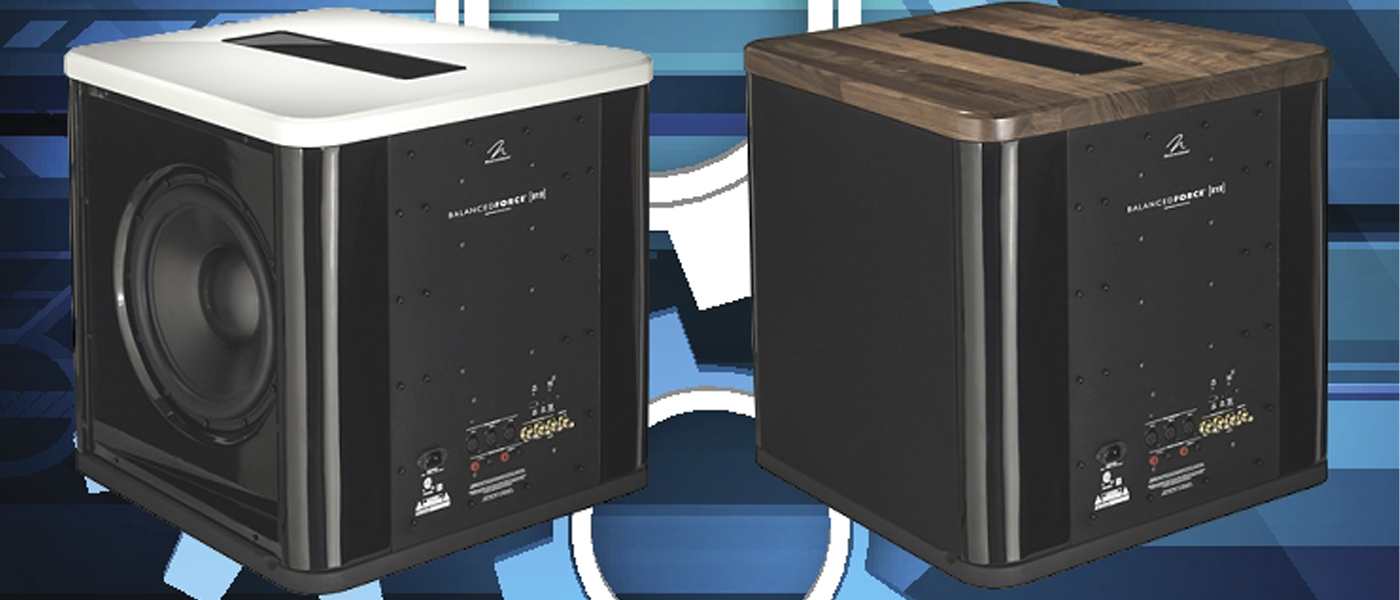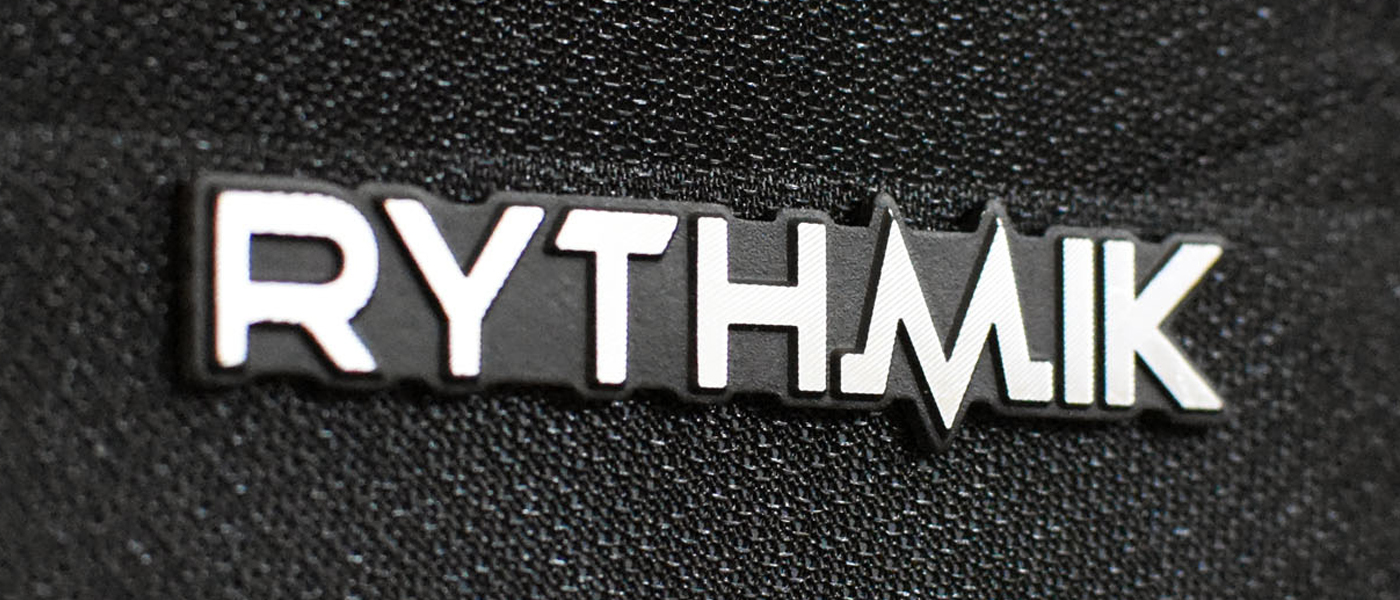
With a focus on subwoofers, the mission of Rythmik Audio is to create subwoofers that reproduce the most accurate bass possible at the best possible price. To achieve the best pricing, Rythmik Audio offers its products through online-direct sales. The company also supports the DIY community by selling subwoofer components and generously providing various subwoofer plans as well as advice. For those non-DIYers, Rythmik offers more than 15 sealed and ported subwoofer models with driver sizes ranging from 8 to 18 inches. Furthermore, all Rythmik subwoofers are claimed to be capable of bass extension to lower than 20 Hz, which is a very desirable attribute.
Rythmik F12SE Subwoofer
- Relatively compact in size for a 12-inch subwoofer.
- The driver and glossy cabinet finish are eye candy.
- Bass extension to below 20 Hz.
- Articulate yet powerful bass output.
Rythmik Audio is a Texas-based audio company specializing in subwoofers. Founded by Brian Ding in 2006, the company’s focus has been on accurate bass reproduction from its subwoofers. The key technology that Rythmik Audio relies on to achieve accurate bass from its subwoofers is the patented servo feedback technique, called Direct Servo. Judging from the critical acclaims that Rythmik has garnered from its products and the success of the company, the utilization of the technology seems to serve the company well in achieving its goal.
Secrets Sponsor
The subwoofer reviewed here is the F12SE, which comes from Rythmik’s 12-inch subwoofer family. The SE indication in the model number stands for Signature Edition, which in this case, refers only to the special cabinet finish. The F12SE, which costs $119 more than the F12, comes in glossy finish instead of the matte black or black oak grain finish of the F12. Except for the finish, the specifications below are valid for both F12 and F12SE.
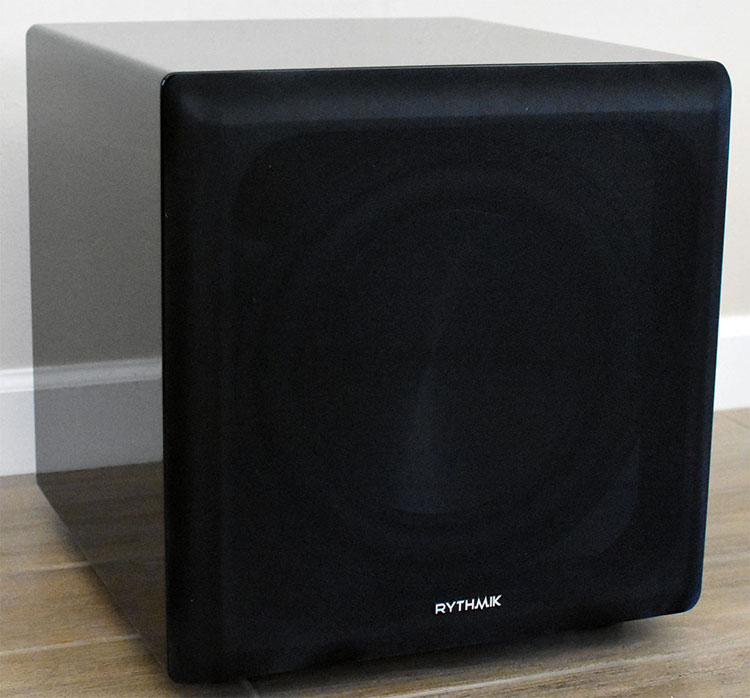
Driver:
12″ high excursion with a custom sensing coil
Driver materials:
Black or silver anodized aluminum with rubber surround
Cast aluminum basket
Amplifier:
370w RMS class H patented servo controlled
Frequency Response:
14 – 200 Hz (-2 dB @ 14 Hz) with LFE inputs in A370PEQ3/XLR2/XLR3
14 – 100 Hz (-2 dB @ 14 Hz) with LINE IN inputs in all models
Crossover slope:
Selectable 12 or 24 dB / octave (PEQ and XLR versions)
Crossover range (Low pass):
25 – 100 Hz
Rumble Filter (High pass ):
20hz 18 dB / octave
Phase response:
<90 degrees phase shift at 20 Hz
Phase adjustment:
0 – 180 degrees continuously variable
Bass damping factor settings:
high (Q=0.5), med (Q=0.7), and low (Q=1.1)
Dimensions:
15-3/4″(W) x 15-3/4″ (H )x 17″(D) (or 18-1/2″ D with grille)
Shipping Weight:
76 lbs
MSRP:
$1099
Company:
Company Directory:
SECRETS Tags:
Reviews 2020, Rythmik Audio, Rythmik Audio F12SE Subwoofer, Subwoofer 2020, Subwoofer Review
The Rythmik Audio F12SE subwoofer utilizes a front-firing sealed-box design. The review sample has a piano gloss finish with black cloth grille. The Rythmik’s website indicates that a gloss white finish with a white grille option is also available. Although the subwoofer looks handsome with the grille on, I think it looks cooler with the grille off exposing its front baffle with its 12-inch black-anodized aluminum driver, which is of a high-excursion type. This driver can be swapped with a silver one for an additional $50 if a more striking two-tone look is desirable.
As mentioned, the main technology behind all Rythmik subwoofers is the Direct Servo technology, which uses feedback to control the movement of the driver. Direct Servo gets its namesake from the fact that the servo feedback is directly tapped into the feedback summing-points of its power-amplifier without passing through any active device, such as an op-amp. Different than most servo subwoofer technologies, which use accelerometers to sense the driver movements, the Direct Servo utilizes a thin sensing coil to detect the driver motions, which is then compared with the input signal to calculate the necessary corrections. Besides reducing distortion, the Direct Servo also ensures consistent frequency response, because the effect of drivers’ mechanical parameter variability is greatly reduced in the closed-loop servo feedback. It also enables the implementation of a low phase shift in the bass roll-off, allowing the adjustment of the damping factor. Rythmik Audio claims that its patented approach will generate more accurate results than the other methods. Regardless of whether this claim is true or not, from the consumers’ point of view, the proof is in the pudding. In other words, it matters only as the result goes.
With Direct Servo technology being able to ensure flat anechoic frequency response from the subwoofer, the company has adopted a pure analog signal path approach. This is very different from other companies’ approaches to using Digital Signal Processing (DSP) to both correct the anechoic frequency response and for room equalization. As a result, Rythmik does not need to bundle DSP with the subwoofer and hence there is no latency delay caused by Analog-to-Digital, DSP, then Digital-to-Analog conversions. This zero-delay feature is crucial to guarantee proper phase alignment between subwoofers and front speakers. The downside of the approach, however, is no remote control nor app to digitally control the subwoofer. All such controls need to be done in the external signal-processing device.
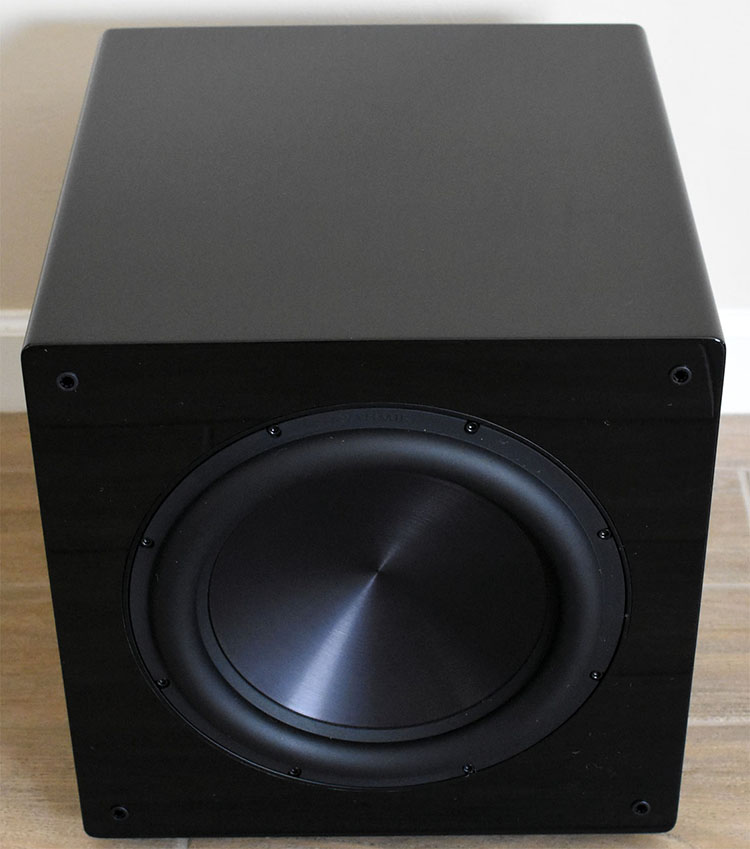
Sizewise, the F12SE is rather compact for a 12-incher. It is not as compact as my Velodyne DD12 subwoofer, which also has a 12-inch single driver, but it is much more compact than most 12-inch subwoofers out there. It makes my other subwoofer, the Paradigm Defiance X12, looks big and bulky in comparison. All things being equal, I prefer a compact-sized subwoofer like this as it is easier to move around and does not take up much space.
The overall build quality of the F12SE subwoofer is excellent. The cabinet of the subwoofer is very well braced and feels rigid. The craftsmanship of the cabinet and the overall assembly of the subwoofer is very good. Complemented by its first-rate finish quality, this subwoofer can really heighten a sense of pride of ownership. The F12SE comes with screw-in rubber feet, which are suitable for placing the subwoofer on the hardwood or tile floor like in my case. Spike feet can be purchased as an add-on if the subwoofer is to be placed on a carpeted floor.
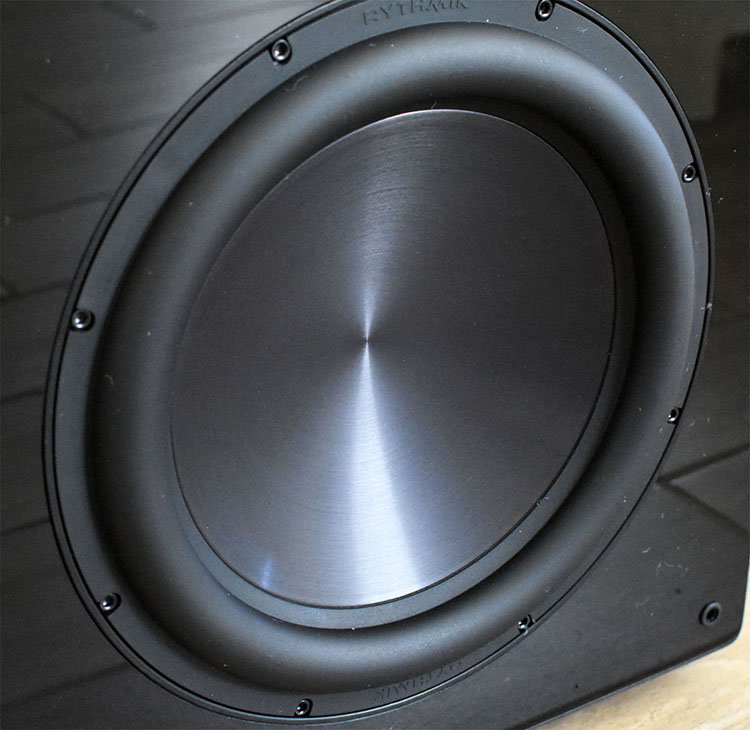
The F12SE comes standard with the A370XLR3 plate amplifier, which is a 370 Watt RMS class H amplifier. The amplifier accommodates both RCA and XLR inputs. Besides the stereo line-level inputs, it also has dedicated LFE inputs for accommodating dual-purpose system setup (stereo music and home theater). In addition to the usual subwoofer controls, e.g. crossover setting, phase/delay adjustment, and volume level, it also provides low-pass slope settings (for seamless integration with the main speakers), rumble filter (to reduce signal content below 20 Hz avoiding wasted power on subsonic signals), as well as bass extension filter adjustments (damping and frequency extension). Unless you are a subwoofer expert, then some of these controls probably sound unfamiliar. Rythmik seems to recognize this very fact, and thus a quick guide sheet is included with the subwoofer that explains clearly the functions of each control and how they should be adjusted. I appreciate this very much as it shows that the company cares about the proper use of its products to get its customers the best outcome. The A370XLR3 amplifier does not have a high-pass filter and speaker-level inputs, but Rythmik offers options to upgrade the amplifier to include these features if desired. For example, for an additional $40, the amplifier can be upgraded to the A370PEQ3 model, which includes speaker-level inputs.

The A370XLR3 amplifier also includes a Parametric Equalization (PEQ) feature, which can be used to equalize the bass response of the subwoofer in the room. Its function is to amplify or attenuate the gain around a frequency. The controls include the center of the frequency to be equalized (selectable between 20 to 80 Hz), the bandwidth of the range of equalization (min to max), and the amount of gain increase (up to 3 dB) or decrease (up to -12 dB). Although the PEQ feature may seem limited as it can only amplify or attenuate around a center frequency, I found it to be quite useful as a lot of times one may only need to deal with a single problematic peak/valley within the subwoofer frequency response range.
Setting up a subwoofer is typically more involved than any other audio component. It involves placement and various control adjustments (level, phase, crossover frequency, and perhaps response equalization) to get the best bass response in the room. As this was not my first venture of using a subwoofer in my audio setup, I know some good locations for subwoofers that will generate a good bass response at my main listening position. For this review, I placed the F12SE near one of the front corners of the room, replacing one of the subwoofers in my dual subwoofer setup. In this location, the F12SE was outside of the plane of the main speakers, which are the Revel Ultima Studio towers. Since the purpose was to evaluate the F12SE performance, the other subwoofer was turned off during most of my evaluation.
The next step was to adjust the subwoofer controls to achieve the best integration with the main speakers. The F12SE had a rather challenging task here, which was to augment the low-frequency response of the Revel Ultima Studio speakers that are not shy in bass output or bass extension to begin with. Before the F12SE was broken in, I adjusted this control by ear, and I was able to achieve what I thought was a good integration with the Revel. The front-end components used were Auralic Aries G1 streamer, Classe CP-500 preamplifier, and Bel Canto Ref500S amplifier (connected through the XLR outputs of the Classe CP-500). The F12SE was connected to the RCA line-level outputs of the Classe CP-500. After I felt the F12SE had sufficient usage to be considered broken in, I refined the adjustments using a more exact approach, that is by measuring the audio response at the listening position. The tools I used were: REW (Room EQ Wizard), which is a free room acoustics and audio measurement software, the calibration microphone that came with Velodyne DD series subwoofers, which is an OEM version of Behringer ECM8000 microphone, a PreSonus Audiobox USB 96, to convert XLR analog to USB digital signals, and a Dell XPS13 laptop, to run the REW software to send the test tones as well as to capture the measurement results. Pre-calibration of the tools prior to the measurements was done using a Radio Shack Sound Level Meter. The measurement was taken with the calibration microphone placed right around the ear level at my main listening position.
Since my main speakers are large and driven with full-range signals, I started the process by first setting the low pass slope on the F12SE to 50 Hz/24, which would give me a 24 dB/octave roll-off slope above 50 Hz. I set the Rumble Filter to off with 14 Hz/high damping combination for the extension filter to get the cleanest most extended bass possible from the subwoofer. From the measurements, I observed that the Ultima Studio’s response started to roll off below 40 Hz in my listening room, which has a width of 16 ft, a height of 9 ft, and open to the other areas in the house with a total length of 42 ft. Hence, I set the crossover on the F12SE to 40 Hz. Then I used a single frequency test tone at 40 Hz to adjust the phase of the subwoofer. At 90 deg phase, with both the speakers and the subwoofer on, I got the loudest response. Hence, I used this phase setting for the rest of my evaluation. I then adjusted the volume level of the subwoofer iteratively until I got what I considered as relatively flat response down to 20 Hz.
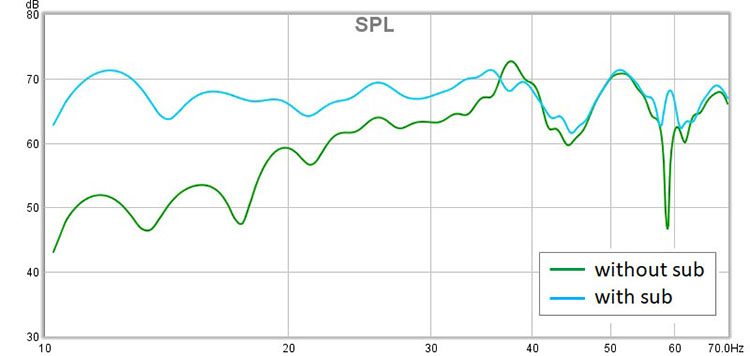
The above figure compares the frequency responses without and with the F12SE at the listening position using a sine-sweep test tone. Only the 10 to 70 Hz frequency range is shown in the figure to better focus on the subwoofer contribution to the response. This comparison clearly shows that the F12SE significantly helped in flattening the lowest audible octave. An 8 dB response improvement at 20 Hz can be observed, which is significant. Impressively, in my relatively large room, the subwoofer was able to generate a relatively flat bass response down to near 10 Hz! At least for the F12SE, Rythmik’s claim of lower than 20 Hz bass extension was substantiated with flying colors.
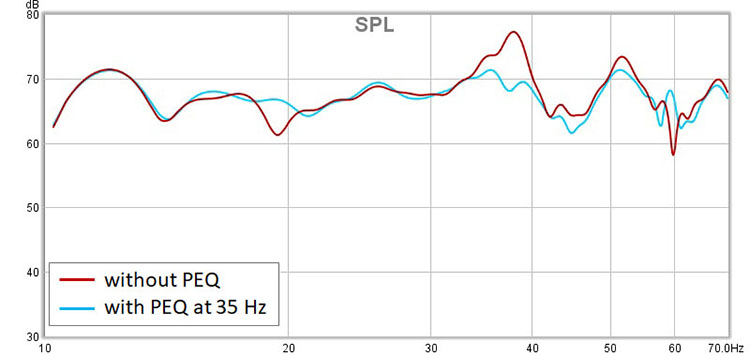
The PEQ feature is useful to further smoothed out the bass in the room by attenuating the obvious peak in the response. In my case, I observed a peak in the frequency response in the upper 30s Hz frequency range, as can be seen from the above figure (red line), which might be due to room acoustics resonance. To suppress this peak, I switched on the PEQ, set the frequency of attenuation at around 35 Hz, a bandwidth of about three-quarter of max, and attenuation of about 10 dB. These settings eliminated the peak in the bass response around that frequency, resulting in smoother overall bass response, as shown by the blue line in the above figure. The PEQ did not seem to affect the frequency ranges outside of the attenuation range, and hence I would not hesitate to use it if such equalization is needed.
Now that I had been able to tailor the F12SE subwoofer response to integrate well with the Ultima Studios and equalize it for smoother room response, it was time for listening evaluation. Various music with heavy bass content were used to evaluate the F12SE performance. Many times during the listening evaluation, I repeated certain musical passages to listen with the F12SE turned on and off for the comparison. Let me start by reporting my impression by saying that the F12SE subwoofer is a very impressive, musical subwoofer. It complimented my Revel Ultima Studio very well by adding a presence in the below-40Hz frequency range with its highly articulate yet impactful bass, even down to the frequency region where you might be able to feel but could not hear. It did so without messing up the frequency spectrum above its crossover frequency. Since I set the crossover frequency of the F12SE relatively low at 40 Hz, I did not experience localization issues that could destroy imaging. The experience was just like listening to a true full-range set of stereo speakers.
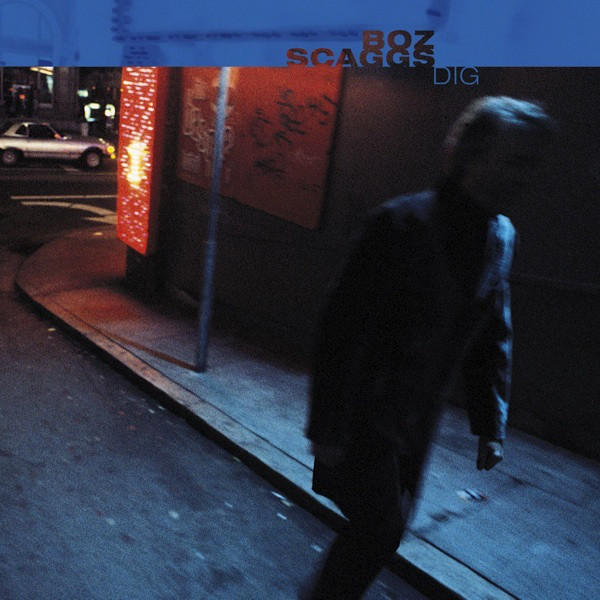
The track Thanks to You from the album Dig (2001) by Boz Scaggs contains underlying low bass throughout. It sounded fine when I listened to my system through the Revel Ultima Studio speakers without the subwoofer. But listening to it with the subwoofer made me realize about some missing low bass notes in the track that were out of the low-frequency reach of the Studio. The F12SE made the track complete by filling in these missing bass notes with ease. It also fleshed out the bass response in the roll-off region of the Studio with better definition, making the bass foundation of the music more pronounced. The track sounded fuller with more weight when the F12SE was assisting in the playback.

On the track Forgiveness by Mandy Moore from her Silver Landings (2020) album, the F12SE contributed to better-defined bass beats as well as more extended bass. The capability of the F12SE to add bass impact while still maintaining the inner texture of the bass was outstanding. With the wrong subwoofer, these inner textures might get smoothed out, resulting in bloated and slow bass. But not with the F12SE, whose Direct Servo technology seemed to induce sufficient agility to track each of the bass notes in the music and present them with clear definition. The F12SE subwoofer never exhibited uncalled for bass overhang which might cause bass muddiness.
Some notable bass-heavy tracks that I used for evaluating the F12SE performance together with the description of the specific bass characteristics are as follows:
- Jerome by Lizzo from Cuz I Love You (2019) album. This track contains a combination of hanging and fast-transient low bass notes, which were conveyed very well by the F12SE.
- Don’t Need the Real Thing by Kandace Springs from Indigo (2018) album. The underlying thumping-bass beats of this track were presented impactfully with good articulation by the F12SE.
- Weather Report by Korean artist Cheeze from Plain (2015) album. The beginning part of the track contains shuddering bass, the texture of which was preserved and presented in great definition by the F12SE.
Even though only a single F12SE subwoofer was used during the evaluation, at normal listening volume levels, I never felt that the F12SE was strained to its limits. Occasionally I pushed my listening volume level to louder than preferred just to test it out, and to my surprise, the F12SE was able to maintain its composure well. In fact, the F12SE seemed to still have the headroom to handle more.
In the home-theater setup, I connected one of the subwoofer outputs of the Marantz AV8802 surround processor to the LFE input of the F12SE. With the Mode switch set to Dual (instead of Normal), the F12SE can accommodate both the line-level and LFE inputs. The delay/phase, crossover, and low-pass slope controls are not usable for the LFE input. This is good logic in my opinion to avoid double control since most new surround processors have their own bass management. In my case, I let the Marantz AV8802 with its Audyssey MultEQ XT32 tool to control and optimize the subwoofer in a 7.1 surround setup.

In general, movie soundtracks with heavy bass effects do push the subwoofer more (in SPL) than most musical tracks. Accuracy in bass is less needed in home-theater than in music applications. Bass volume (SPL) and impact are the more important aspects in home theater. I found that the settings that worked best for music might not be suitable for use in home-theater applications. Activating the rumble filter switch and reducing the bass extension setting in the F12SE in favor of SPL are usually desirable in home-theater use. As good as the F12SE is, I would not categorize it as an SPL champion. Using the music settings (very-low bass extension with no rumble filter), I did hear the F12SE hit its limits (clipping) on some of the heavy bass-demanding sound effects in the movie The Old Guard (2020) when played at a rather high volume. Lowering the subwoofer’s gain setting and engaging the rumble filter as well as reducing its bass extension setting remedied the situation. When played within its SPL range, the F12SE produced tight yet impactful bass complementing the music and various action scenes in the movie well. The bass it produced always felt controlled and never sounded loose or boomy, which might be the attribute of its Direct Servo technology.
Despite the SPL limitation that I encountered, in my opinion, the F12SE has sufficient volume and bass quality to make it a solid performer for home-theater applications. And remember that only a single subwoofer was used in this evaluation in my relatively large room. So, the F12SE was really pushed hard in this situation. I don’t think I would hit the limit of the F12SE SPL capability if two of these were used
Secrets Sponsor
Some Comparison Remarks
Design-wise, the closest subwoofer to the F12SE that I have in my system is the Velodyne DD12. Both have a single 12-inch driver in a sealed box design. Also, both subwoofers employ driver feedback control, albeit with different servo technologies. Their price tags, however, are widely apart. The DD12 has long been discontinued, but when it was available, it carried almost three times the F12SE price. The DD12 indeed offers more features than the F12SE, including a more powerful amplifier (1250 W class D amplifier), DSP with room equalization, remote control, and a calibration setup kit. Set up properly, both subwoofers could perform well in augmenting the lower end of the Revel Ultima Studio’s response. Measured at the listening position, the F12SE actually had lower bass extension below 20 Hz range than the DD12. Within the audible frequency range, both were competent performers down to 20 Hz, producing articulate and tight bass with excellent impact. In home-theater applications, I liked the quality of bass produced by both, however, the DD12 seemed to be capable of delivering higher SPL before clipping than the F12SE. Also, the DD12 offers more convenience in switching between audio and home-theater applications as it can save settings as presets that can be recalled using the press of a button on its remote control. In my opinion, however, the slight edge in SPL and operational convenience that the DD12 has over the F12SE does not justify the hefty price difference. Moreover, remote control and digital interface features may introduce digital latency delay. To me, the fact that they are neck and neck for most other aspects of performance makes the F12SE a much better value proposition between the two.
Beyond its excellent build quality and finish, the Rythmik F12SE subwoofer offers first-rate bass performance that brings significant value beyond its $1099 asking price.
- Handsome looking, compact size, and good build quality
- Customizable amplifier features
- Capable of producing deep bass response below the 20-Hz range
- Excellent bass quality and performance
- Remote/wireless control feature
The Rythmik F12SE subwoofer is a true high-performance subwoofer in the literal sense. Despite lacking convenience features, such as remote/wireless control, the F12SE delivers first-rate bass performance. With its Direct Servo technology, the bass produced by the F12SE subwoofer always sounds controlled and articulate with good attack. The capability of the subwoofer to produce flat bass output down to the subsonic range is impressive. The F12SE with its A370XLR3 amplifier provides sufficient bass response control for seamless integration with the main speakers in stereo music applications. The term ‘subwoofer for discerning audiophiles’ describes the F12SE fittingly. The F12SE subwoofer is also sufficiently capable of handling the low-frequency effects in home-theater applications. Complimented by its handsome appearance and compact size, this excellently-built subwoofer brings tremendous sub-woofing value at its $1099 asking price. The Rythmik F12SE subwoofer easily earns my highest recommendation for a high performance-to-cost ratio subwoofer.


